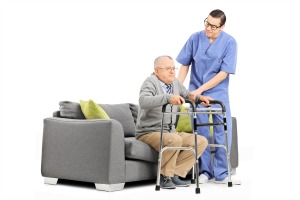July 30, 2014
Author: , LPN
Falls are among one of the leading causes of injuries for seniors sixty five and older. Falls can result in head trauma and fractures. Healthcare providers must take a closer look to identify new preventive measures. What are we looking for? The answer is enhanced “best practices”.
A deeper look for fall prevention must involve all members of the care plan team. Let’s review the acronym L.O.O.K. ™ L.O.O.K. entails – L – Learning the causes/risk factors of the falls – O – Observing the risk factors frequently – O – Obligation, maintain our commitment and responsibility – K – Keep being persistent for better solutions. The plight of fall safety is becoming a key priority for hospitals, assisted living facilities, skilled nursing facilities and home health. The following risk factors should be considered in fall prevention. Unsafe floors, spilled liquids, chronic conditions (arthritis, incontinence, dementia) assistive devices, improper use of assistive devices, improper shoes, impaired vision, advanced age, medication side effects, balance/gait problems and impulsive behaviors to name a few.
Frontline caregivers are the primary care members who are likely to notice a patient/resident at risk for a fall during the course of their daily shift. Involving these caregivers in a safety committee is a vital aspect of the L.O.O.K. ™ acronym. Caregivers can almost anticipate who is likely to fall on a daily basis based on their fall risk lifestyle. Examples, a resident forgetting to use both handles of a walker, a resident who is likely to sit on a parked rollator/ottoman or a family member using a rollator as a wheelchair. Observing a resident’s daily mobility mannerism is a key factor as well.
Best practices must be a part of healthcare provider’s daily practice. Encouraging frontline caregivers to report/document a simple change in a resident’s balance, a change in transferring, or difficulty using assistive devices, or difficulty with movement/mobility must be reported immediately. Remember to L.O.O.K. ™ for preventive measures for the safety and increased quality of life for our seniors. Best practices should also involve increased safety measures. Frontline caregivers must to alert to external causes which may cause falls. These external causes can be spills, untied shoes laces, pants that are too long, broken assistive devices/furniture, broken glasses, loose rugs, electrical cords, pets, and poor lighting. Nurses play an important role in best practices for fall prevention. These practices can include:
- Assess the resident for proper assistive devices and educate the staff.
- Perform quarterly balance/gait/strength assessments
- Update care plans post falls
- Participate in QAPI (Quality Assurance Performance Improvement) meetings. QAPI is a proactive study of process of identifying system challenges by creating new solutions and approaches to improve the causes of the challenges.
- Provide ongoing meetings, trainings and assessments
As the senior population continues to increase, falls will increase too. Healthcare providers must be willing to meet the needs of fall prevention and identify the risk factors early. National Fall Prevention Day occurs annually on September 22. Implementing a community based event can be noted as one of your agency’s best practice on this day.
Virginia Ann Peterson, LPN
Virginia Ann Peterson, LPN is an active community educator with decades of experience in the nursing profession. Her work history is highlighted with various positions which include nursing supervisor, hospice, staff development, in-service education, nursing assistant instructor and currently an assisted living facility reminiscence coordinator. She is also currently sharing her expertise as an outreach volunteer.
Ms. Peterson is the author of several webinar presentations geared toward frontline caregivers. She is very active in educating the senior population on wellness within her church and community. She is a member of a Gerontology ministry and serves as a member on the Health and Wellness committee at her church. Ms. Peterson holds a certificate of Professional Gerontology course from UGA (University of Georgia).
Ms. Peterson is a certified Train-The-Trainer which she is eligible to train nursing assistant students in her home state or Georgia. She also is an EDNA (End of Life Educator for Nursing Assistants). She is the past President and Vice President of the North Georgia Hospice Nursing Association and is a current member of the Georgia Gerontology Society.
During her spare time she volunteers for a local hospital as an Ambassador for a Joint Solution Center for patients anticipating joint replacements. As an ambassador, she shares valuable information at Doc Talks and she has participated in an ongoing television commercial for the hospital’s Joint Solution Center program.
